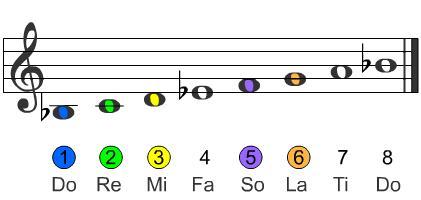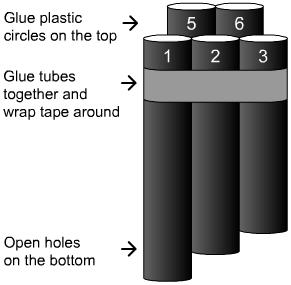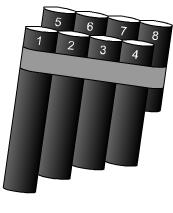Melodic Tube Drums
On this page, you will learn how to make a set of tubular drums that can play melodies! It includes: 1) Virtual Tube Drums you can play right now on your computer; 2) directions on how to build a 5-note set of tube drums; and 3) information on building and playing an 8-note set of tube drums. So take a couple of minutes, hear the tube drums and learn how to make this instrument!

As you will hear, the longer the tube, the lower the pitch — the shorter the tube, the higher the pitch.
Click the Play button below to hear the instrument. The sounds you hear were produced by playing each drum by hand. If you would like to make this instrument, just follow the directions below.
Building a 5-note set of Melodic Tube Drums
Begin by getting approximately 10 feet (3 meters) of 2-inch diameter ABS pipe.
| Inches | Centimeters | ||
| Bb | 27 3/4 | 70.4 | 1 |
| C | 24 5/8 | 62.6 | 2 |
| D | 21 5/8 | 55.0 | 3 |
| F | 17 13/16 | 45.2 | 5 |
| G | 15 7/8 | 40.3 | 6 |
1) Cut the tubing into the five sections listed on the left. 
2) Cut five 2-inch circles from a rectangular plastic baby wipe container.
3) Glue a plastic circle on top of each tube — allow the glue to set.
4) Arrange tubes 1, 2 & 3 over a piece of duct tape that is 30 inches (76 centimeters) long. Apply a drop of glue between each tube in line with the duct tape.
5) On tubes 1-3, apply drops of glue (in line with the duct tape) where 5 & 6 will make contact. Carefully place tubes 5 & 6 on top of tubes 1, 2 & 3. Position tubes 5 & 6 to be 1-inch (3 centimeters) higher than tubes 1, 2 & 3.
6) Apply a drop of glue between tubes 5 & 6, and tightly wrap the duct tape around the 5-tube set — allow the glue to dry before moving the instrument.
7) After the glue is completely dry, hold the instrument under your left arm and play with your right hand. Quickly strike/tap the drum heads (plastic circles) near the center to produce the best sound — as shown below.
If you would like to build an 8-note set that plays many more songs, see below.
Building an 8-note set of Melodic Tube Drums

 Phil and his daughter,
Sarah, have created a special resource on
building and playing melodic tube drums that includes step-by-step
instructions. Just like our
water bottle xylophone, glockenspiel,
panpipes, fraction
tubes, and didgeritubes, our melodic tube drums are tuned to play an 8-note scale in the key of C.
Phil and his daughter,
Sarah, have created a special resource on
building and playing melodic tube drums that includes step-by-step
instructions. Just like our
water bottle xylophone, glockenspiel,
panpipes, fraction
tubes, and didgeritubes, our melodic tube drums are tuned to play an 8-note scale in the key of C.
Building instructions are at
Melodic Tube Drums.pdf.
In case you'd like to build a larger set, the instructions also include an
addendum for Science Olympiad, detailing the measurements for a fully chromatic
27 tube set.

For sheet music written in treble clef, and play-along music tracks, check out Phil's Music for Homemade Instruments page.